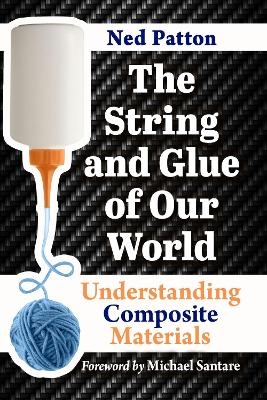
The String and Glue of Our World
McFarland & Co Inc (Verlag)
978-1-4766-9133-6 (ISBN)
This is a book about composite materials, written from the perspective of someone who has been in the industry for more than four decades and had to learn about them the hard way. Aimed at the curious citizen scientist or maker, it is written in an accessible, entertaining, and jargon-free style, introducing and explaining the how and why of composite materials.
Following a history of composites, the book discusses the periodic table of elements and why getting to know this table is so important. It then introduces strings (fibers) and glues (matrices or resins) and explains how they're put together, how to design with them, and how to analyze what you've designed. The work also describes the composites business and includes a list of good schools and their involvement with industry.
Ned Patton, Ph.D., P.E., has more than 40 years of experience in research and technology development, and has been involved with composites for 35+ of those years. He works at Northrop Grumman Marine Systems as a senior technical professional, and is actively developing composite material parts and structures for use undersea. He lives in Sunnyvale, California.
Table of Contents
Foreword by Michael Santare
Preface
Introduction
1. A Brief History of Composites
2. Composites and the Periodic Table of the Elements
Protons, Neutrons, Nucleus of an Atom, Electrons, Atomic Number, Electron Orbitals, Valence Electrons—What Are These Things?
Carbon
Silicon
Oxygen, Nitrogen, and Hydrogen—Elements That Make Up the Glue
3. Composite Fibers—the String
Carbon Fiber
Graphite
Glass Fiber
Other Fiber Types
Aramid Fibers
Other Organic Fibers
Boron Fiber
Silicon Carbide Fiber
4. The Glue—a.k.a. Composite Resins
Phenolic Resins
Polyester Resins
Vinyl Ester Resins
Epoxy Resins
Other Epoxies
Epoxy Curing Agents
Thermoplastic Resins
5. Making Something Out of Composites
String and Glue Product Forms
Composite Molding Processes
Hand Layup and Open Molding
Closed Molding Processes
Filament Winding of Composites
Pultrusion
6. Brief Introduction to the Mechanics of Composites, Ply Stacks, Unidirectional vs. Fabric
Mechanical Properties of Fibers
Mechanical Properties of Resins
Calculating the Mechanical Properties of a Single Ply
Mechanical Properties of a Ply of Fabric
Brief Introduction to the Effective Properties of a Laminate
About Allowable Stresses and Strains
Thicker Laminates and the Stiffness Matrix
7. Designing Something Using Composites
Where to Start—a Good Set of Requirements
What to Do—Makeup of a Composite Design
What to Do with This? Some Examples
Towed Vertically Directive Source—Ten Pounds in a Five-Pound Sack
Composite Reinforced Natural Gas Pipeline—Can’t Do This with Steel
NDE Calibration Blocks—How Do You Tell If It’s a Crack or Delamination or Just a Ply Drop? Or Maybe Your NDE Instrument Had a Bad Day?
Carbon Fiber Bicycle Frames—Go Faster, Win the Tour de France
8. Failure—How and Why Composites Break and How to Avoid It
Microscopic Composite Failure Types (Modes) and Mechanisms—How and Why
Fiber Failure
Resin or Matrix Failure
Fiber-Matrix Debonding
Macroscopic Composite Failure—It’s All About the Interfaces
Bonded Joint Failure
Bolted Connection Failures
Delamination and Ply Peeling Failures
Failure Initiation at Ply Drops and Section Thickness Changes
Failure Prediction—How to Avoid Disaster
Bulk Composite Failure Prediction
Fracture Mechanics and Composites
9. Computer Based Tools for Composites—3D Models and FEA
Stand Alone Tools for Composites Design and Analysis
ESP Composites
AnalySwift
CDS: Composite Design Software—University of Delaware
Digimat—e-Xstream
Fibersim—Siemens
Helius: MCT
CompoSIDE
Composites and Major Engineering Simulation Programs
Abaqus—Dassault Systèmes Simulia
Ansys Composite PrepPost
MSC Nastran/Patran
Femap/NX Nastran
Solidworks—Dassault Systèmes
10. Other Types of Composites
Discontinuously Reinforced Composites—Chopped Fibers and Particles
Plastic Matrix Discontinuous Composites
Metal Matrix Discontinuous Composites
Non-Plastic Matrix Continuous Fiber Composites
11. The Business of Composites
String Supply Business
Glass Fiber Business, Market, and Future
Carbon Fiber Business, Market, and Future
Aramid Fiber Business, Market, and Future
Polyethylene and Polyester Fiber Business, Market, and Future
Glue Supply Business
Polyester and Vinyl Ester Resin Business, Market, and Future
Epoxy Resin Business, Market, and Future
Phenolic Resin Business, Market, and Future
Composite Design and Fabrication Business
12. Jobs and Schools in Composites
Getting a Job in Composites Without a BS Degree in Mechanical Engineering
Getting a Job in Composites with a BS in Mechanical Engineering
Good Composites Universities
University of Delaware’s Center for Composite Materials
Northwestern University
MIT
Georgia Tech
Stanford
UC Berkeley
UCLA
UT Austin
Rice University
Penn State
University of Washington
13. Final Thoughts
Chapter Notes
Bibliography
Index
| Erscheinungsdatum | 18.08.2023 |
|---|---|
| Zusatzinfo | 81 photos, notes, bibliography, index |
| Verlagsort | Jefferson, NC |
| Sprache | englisch |
| Maße | 152 x 229 mm |
| Gewicht | 318 g |
| Themenwelt | Technik ► Maschinenbau |
| ISBN-10 | 1-4766-9133-9 / 1476691339 |
| ISBN-13 | 978-1-4766-9133-6 / 9781476691336 |
| Zustand | Neuware |
| Informationen gemäß Produktsicherheitsverordnung (GPSR) | |
| Haben Sie eine Frage zum Produkt? |
aus dem Bereich


